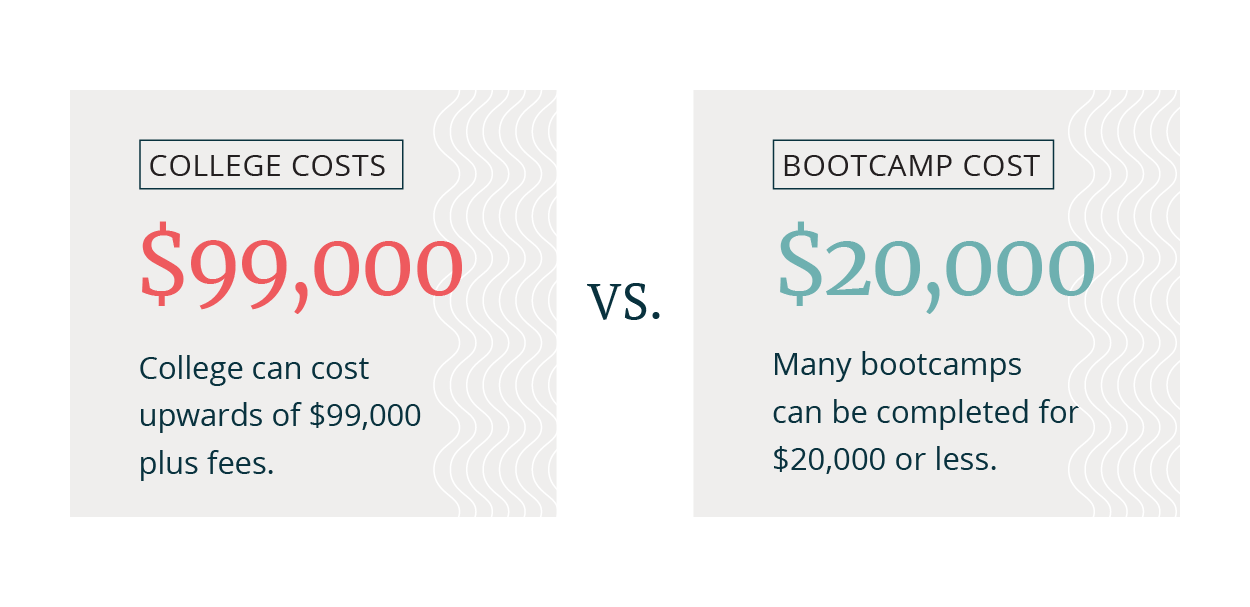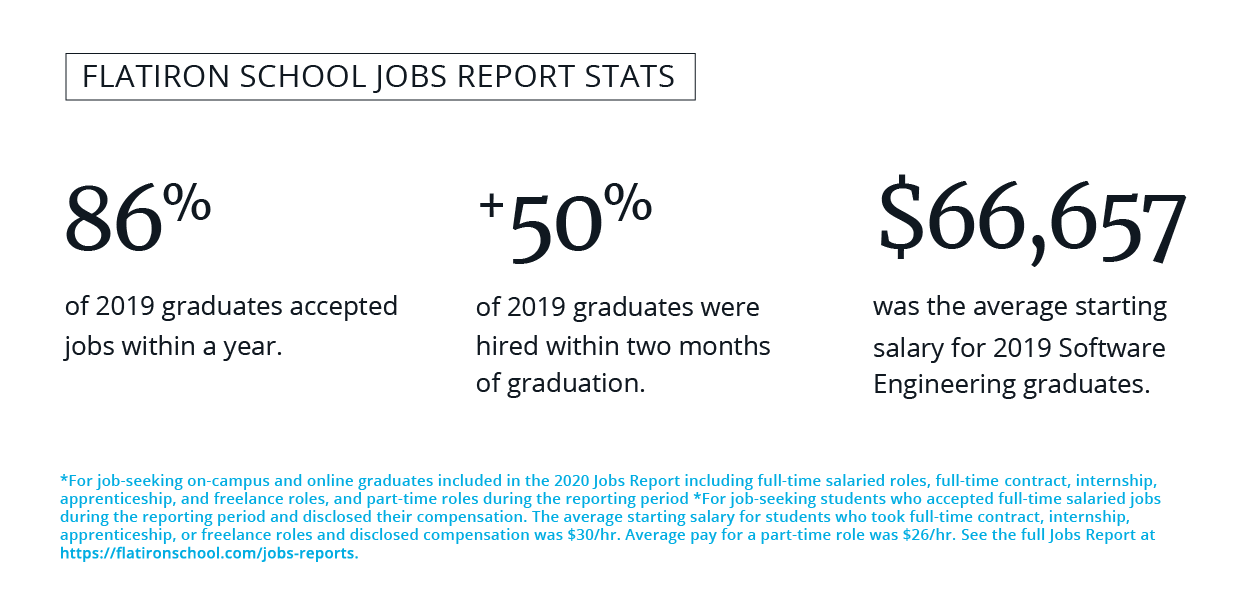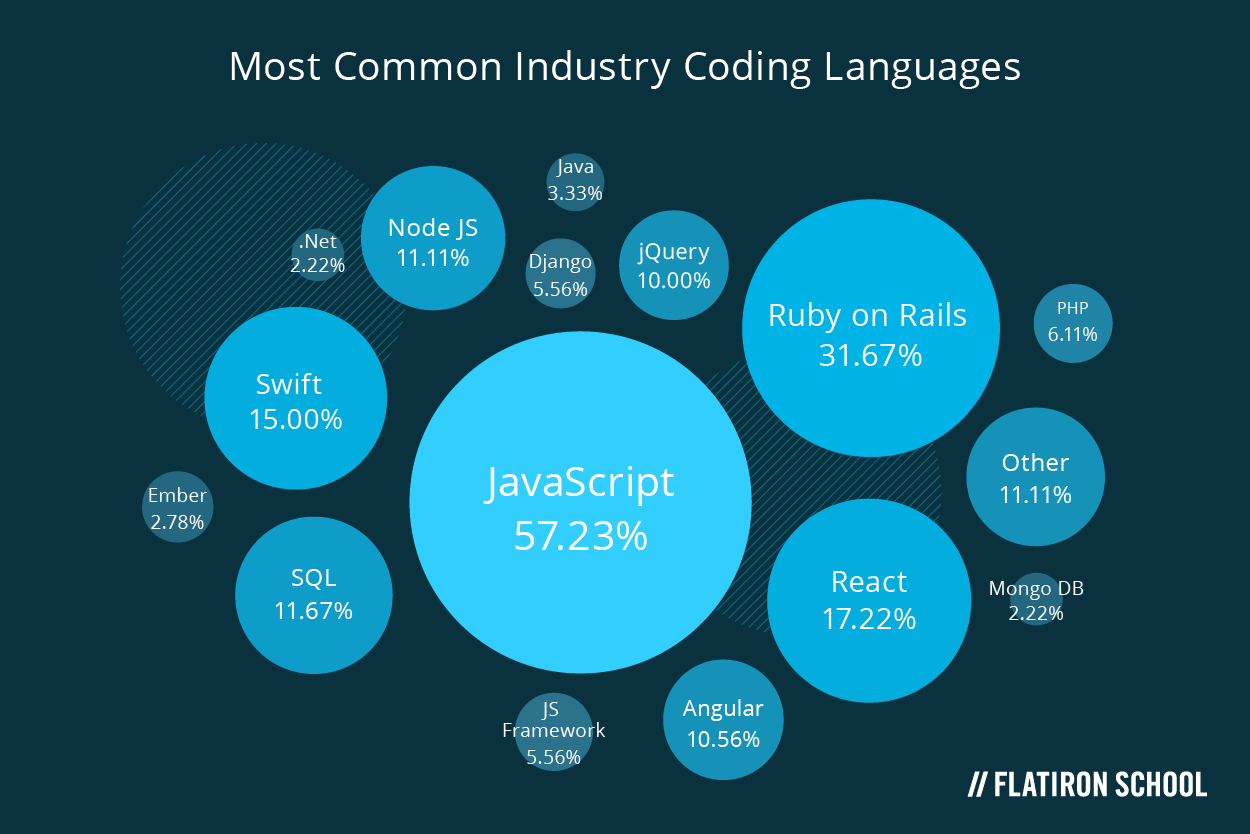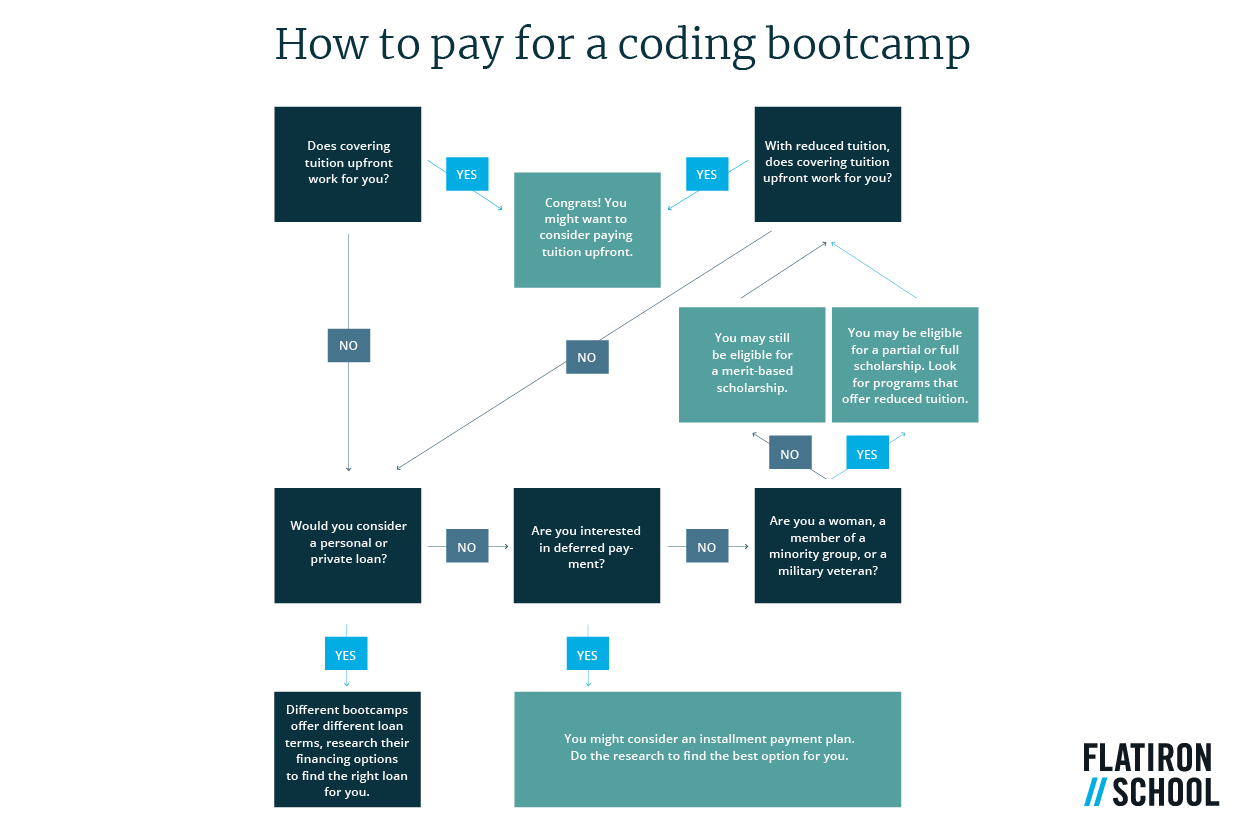The tech industry is a pervasive part of our lives — from smartphone apps and drones to big data that companies use to make decisions about the future — tech is everywhere. Tech careers can be exciting and fulfilling, plus they often offer higher paychecks and more flexible lifestyles allowing for remote work, and perks such as free lunch, massages, and kombucha on tap.
Getting ready for a career in tech means finding the right training, but things can get confusing when you start your online research. There are tons of intensive training programs that promise to help you quickly learn the skills in order to start your next career soon—and they’re all a little different.
Sorting out the programs, understanding what they offer, and choosing the best course can be a challenge.
This eBook is your guide to the most frequently asked questions about where to learn to code, how to fit a coding bootcamp into your schedule, what you’ll learn, and how to pay for it.
What is a coding bootcamp?
A coding bootcamp is an intensive training course that teaches beginners to code and gives them the practical skills they’ll need to land a tech job. More than 33,000 U.S. adults graduated from bootcamps in 2019, according to Career Karma, and the number of bootcamp students is on the rise.
Bootcamps take only a few months to complete, as opposed to going back to university for four years, and bootcamps typically have more intensive job-placement support than a college or university. Those are two big reasons that working adults seek out bootcamps when they want to change careers.

And don’t forget the cost difference. College can cost upwards of $99,000 plus fees, where many bootcamp programs can be completed for less than $20,000.
Should you teach yourself to code for free?
Good question. There are plenty of free resources online to help you learn to code. In fact, some bootcamps offer free coding lessons for beginners in HTML & CSS, JavaScript, Ruby, and API Integration. These free lessons are a great way to see if you like the work before committing to a coding bootcamp.
That said, paid software engineering training courses offer benefits you don’t get when you’re learning on your own. For instance, if you want to learn coding in order to get a job, some employers will prefer the kind of formal training you get at a bootcamp.
Benefits of learning in a coding bootcamp

1. A supportive learning environment & community
Whether you do your bootcamp in person or online, a good school will make sure you have opportunities to engage with your learning community, including:
- Interactions with your instructor, in person or over video and chat.
- Group projects and paired programming sessions with your classmates.
- Dedicated chat channels, panel discussions, and project showcases.
Learning from an instructor can help you move past stumbling blocks you might run into learning on your own. Collaborating with your peers is excellent practice for a career in tech.
2. Practical instruction with real-world problems
Building UIs for web apps, debugging code, creating reusable objects, and building HTTP servers are just a few of the projects students can take on during our Software Engineering course. For most students, these kinds of hands-on tasks are easier to learn with guidance from an experienced instructor and input from other students.
3. Individual career coaching and a proven job-search framework
Some bootcamps offer career coaching before you graduate and for months after. But the best bootcamps will include 1:1 coaching for students so they can land a great first job in their new career.
For example, Flatiron School’s career coaches start working with students about 30 days before graduation and offer support for 180 days after graduation.
4. A verified record of graduate job placements and salaries
Because of the intensive training, job-ready portfolio, and career guidance—and the fact that bootcamp students are highly motivated—bootcamp graduates typically have a good track record of getting hired quickly in their new industry.
Of course, results can vary, and each school is a little different. Before you choose a course, look for their most recent jobs report. It should include the percentage of new graduates who accepted a job in their field within a year and the average starting salary for new graduates. Ideally, the school will have a third party verify their numbers.

Flatiron School’s 2020 Jobs Report shows that:
- 86% of 2019 graduates accepted jobs within a year.*
- More than half were hired within two months of graduation.*
- Their average starting salary for 2019 graduates was $66,657.**
*for job-seeking on-campus and online graduates included in the 2020 Jobs Report including full-time salaried roles, full-time contract, internship, apprenticeship, and freelance roles, and part-time roles during the reporting period (see full Jobs Report here).
**For job-seeking students who accepted full-time salaried jobs during the reporting period and disclosed their compensation. The average starting salary for students who took full-time contract, internship, apprenticeship, or freelance roles and disclosed compensation was $30/hr. Average pay for a part-time role was $26/hr (see full Jobs Report report here).
What Kind of Coding Bootcamp Will Work Best for You?
The right course will teach you what you need to know, fit within your schedule, and provide career services support so you can get a job.
Here are the 3 things you should consider when deciding on the right bootcamp for you.
-
Which programming languages do you want to learn?
This is a key question, because there are a lot of programming languages used in software engineering. Here’s a graph of the most common languages our graduates work with—including the ones they learn on the job after graduation. For example, this chart shows the most common coding languages that graduates use after they get a job.
According to a Flatiron School graduate survey, these are the most common languages that are used in the industry by bootcamp graduates.

Here’s what you’ll learn in the coding bootcamp at Flatiron School:
- HTML & CSS
- Git Commands
- Object Relational Mapping & SQL
- JavaScript
- React
- Ruby
- Rack
- Rails
The program at Flatiron School also covers popular frameworks like Redux for building user interfaces. For more details on which languages matter most and why, check out our comprehensive post on what languages to learn.
Once you know which programming languages you want to learn for your career goals, choose a coding bootcamp that teaches the coding languages you want to learn. Any reputable coding bootcamp should list this in their curriculum or syllabus.
2. How much time can you dedicate to your class?
One major benefit of a bootcamp is that you can choose the pace and length of the program. While going back to college for four years might not be possible for everyone, a coding bootcamp offers a shorter program with hands-on projects that will prepare you for the career field.

Some bootcamps offer full-time programs where you will be learning in a “live lecture” format for about nine hours each weekday, plus time for studying, of course. This option will allow you to complete a program in as little as 15 weeks. This option could be called the “fast track” option, if you have the time in your schedule to dedicate to your studies.
But, if you need more flexibility in your daily schedule, a flexible pace option might be more your speed. A flexible pace bootcamp is likely a recorded lecture format. This gives you the freedom to plan around your already-busy schedule, but might not be the best option if you like more structure. Plus, flexible pace options are a little longer, allowing you to complete the program in 20, 40, or 60 weeks, for instance. Even though you’re setting your own schedule, you will need extra time for studying and working on projects.
Be realistic about the time you can commit to classes and studying, and look for a program that offers the pace that best fits your lifestyle. After all, this is a big investment, and it should work for you and your schedule so that you can successfully complete the program and start your new career.
3. What is your preferred style of learning?
Do you prefer live or on demand lectures? Do you want to learn with a dedicated cohort of students or are you OK learning independently?
This decision comes down to personal preference. Look for a school that has the learning style where you are most likely to succeed. Some schools will offer in-person and online options. Others might be entirely on-site campus programs. Research this thoroughly to determine all possibilities, and then choose the one that best fits your learning style.
The option you choose will depend on lots of factors, like how much time you have to commute and whether you have child care, but the key factor should be how you learn best. A bootcamp is a big commitment, and you’ll get the most value if it fits your learning style.
Attend a free event or info session on how to start your tech career, what you’ll learn in our software engineering course, and more.
How will you pay for your software engineer training program?
Average tuition for coding bootcamps in 2020 was $13,584. That’s a lot, but training program grads earn a median of $65,000 in their first jobs after graduation.
Also, bootcamp tuition is a lot less than a 4-year computer science degree, which can range from $50K to $100K. Still, most of us don’t have an extra pile of cash in our wallet, so comparing tuition costs, payment plans, and scholarship opportunities is part of finding the right program.

Payment Option 1: Pay out of pocket
If you can pay cash, you’ll avoid loan interest and fees. Typically, your course will require a deposit and then you’ll either pay the balance as a lump sum or as installments during the course.
Questions to ask:
- What forms of payment do you accept—credit cards, online transfer, something else?
- Is there a discount for paying as a lump sum instead of financing?
- What are the payment deadlines?
- What are the late payment fees?
Payment Option 2: Get a private-lender loan
Unlike traditional four-year university programs, coding courses don’t qualify for federally sponsored student loans. That means you don’t have to deal with the FAFSA bureaucracy to get your loan, and you can get a private loan from the lender of your choice.
Many training schools partner with lenders to offer loans for their courses. These lenders will usually show you a sample loan and repayment plan when you visit their website or after you share a little information, so you can compare your loan options fast. You may even be able to get a cost-of-living loan to help out while you’re taking your course.
Questions to ask:
- Do you offer tuition-only loans, or can you also get a cost-of-living loan?
- How long does it take to get approved?
- What are the fees?
- What’s the interest rate?
- What’s the total cost of the loan?
- What are the monthly payments?
- When do you start making payments?
- How long will it take to pay off?
Learn more about your private loan options.
Payment Option 3: Look for scholarships
You may be able to cover some or all of your costs with scholarships. The schools you’re considering may have their own scholarship programs, like Flatiron School’s Access Scholarship, which offers qualified applicants up to $3,000 scholarship. Recipients can enroll without making a tuition deposit. Another example is the National Center for Women & Information Technology scholarship that provides full-tuition scholarships to women in Alabama and Michigan who apply for online Flatiron School courses.
Questions to ask:
- What are the eligibility requirements?
- When are the application deadlines?
- When will you know if you’re getting a scholarship?
Why you should take a coding bootcamp at Flatiron School

Our grads have landed at major tech employers including Apple, Spotify, NASA, and Slack and we’re winning awards along the way, including Career Karma’s Best Coding Bootcamps for Q1 2020 and Course Report’s Best Bootcamp 2019–2020.
Plus, like we mentioned earlier, you’ll get 180 days of 1:1 career coaching included. We have a proven job-search framework that was created to help you get a job. Whether you’re ready to learn full-time or need more flexibility (a 20, 40, or 60-week program), we have the program to fit your needs.
Book a 10-minute chat with our admissions team to learn more about our program.
Your Software Engineer Bootcamp Checklist
Now that you know the most important factors in choosing a software engineering course, it’s time to put it all together, complete your research, and make your choice. It’s a lot, so we’ve pulled together this checklist to help you evaluate each program you’re considering.
Does the training course or bootcamp you’re looking at have:
- Core software engineering languages:
-
- HTML & CSS
- Git
- SQL
- JavaScript
- Ruby
- Full-time and flexible schedule options
- Live, experienced instructors
- Access to on-campus and online resources
- Paired and group projects to prepare you for real work scenarios
- Capstone projects to build your portfolio
- An engaged learning community of classmates, instructor, and career coach
- 1:1 career coaching for 180 days after graduation
- High, verified graduate placement rates and high average starting salaries?
- Workable options for paying tuition, like partnerships with private lenders and sponsored scholarships
- Employer partnerships with industry leading company such as Amazon, Facebook, and NASA
- High-quality student job placement rates with top tech companies such as Spotify, Salesforce, and Apple
When you find a course that ticks all the boxes, you’re ready to start training for your new career.
Ready to change things? Apply now and get started.
- Footnote 1: https://www.nerdwallet.com/article/loans/student-loans/how-much-is-coding-bootcamp NerdWallet, How Much Is Coding Bootcamp.
- Footnote 2: https://www.coursereport.com/blog/web-developer-salaries-after-coding-bootcamps Course Report, Web Developer Salaries After Coding Bootcamps.
- Footnote 3: https://www.geteducated.com/online-college-ratings-and-rankings/best-online-bachelors-in-computer-science/ Get Educated, The 25 Most Affordable Bachelor’s in Computer Science Online.




